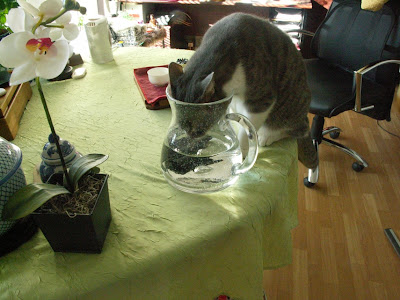 This 1970s, 500 grams, Golden Mellon raw puerh looks like it came from a Halloween Party. It's white, torn wrapper looks kind of ghostly. But underneath the cloth, the puerh buds appear small, clear and beautiful. From the outside layer, it seems that only very high grade leaves went into this tightly pressed Jingua. (I have also made samples with this Jingua and so I could see that the inside matches the outside and is only made of small buds). These leaves are not coming from a wild habitat, but from plantation trees.
This 1970s, 500 grams, Golden Mellon raw puerh looks like it came from a Halloween Party. It's white, torn wrapper looks kind of ghostly. But underneath the cloth, the puerh buds appear small, clear and beautiful. From the outside layer, it seems that only very high grade leaves went into this tightly pressed Jingua. (I have also made samples with this Jingua and so I could see that the inside matches the outside and is only made of small buds). These leaves are not coming from a wild habitat, but from plantation trees. 

Scents: From dry earth to stable over to old wood, all classic old puerh smells can be found in this Jingua. Despite the profusion of smells, it is interesting to smell how clear and pure they are.

 Sight:The tea liquor is also very clear and transparent despite its dark brown color. It's even shiny. And during the first minute, you can see a white fog on the top of the tea liquor. This confirms the high quality of the leaves used in this Jingua.
Sight:The tea liquor is also very clear and transparent despite its dark brown color. It's even shiny. And during the first minute, you can see a white fog on the top of the tea liquor. This confirms the high quality of the leaves used in this Jingua.The taste: The result is a very smooth and round taste. One that says 'give me more'. Pushed to its limits, some astringency and sour taste may appear, but most of the time the brew was so smooth and fine that it almost felt like it disappeared. I remember saying to myself that I feel 'a presence', but almost too faint to grasp. A few hours later, my son reminded me of his upcoming Halloween party. This reminded me of this puerh, because, like a ghost, I could somewhat feel it, but never attain it. Not because it would disappear quickly -it lasts quite long-, but because it tends towards the neutral taste.
I had tried it two years ago, but liked it much more this month.
 The open leaves show how small the leaves are.
The open leaves show how small the leaves are.  Conclusion: This Jingua is made with very beautiful leaves that bring a high purity to sight, scents and taste. It doesn't have a direct way of expressing itself. The -usually- heavy old puerh smells are light and the aftertaste is evanescent. It is more reminder of his old self, a ghost of old puerh.
Conclusion: This Jingua is made with very beautiful leaves that bring a high purity to sight, scents and taste. It doesn't have a direct way of expressing itself. The -usually- heavy old puerh smells are light and the aftertaste is evanescent. It is more reminder of his old self, a ghost of old puerh.Note: This Jingua costs twice as much as a 1985 wild Yiwu Tuo Cha. (It also weighs twice as much). I have also prepared samples of it. But because it is heavier, I prepared 20 samples (of 25 grams) with 1 Jingua. This means that a sample of this Jingua weighs and costs the same as a sample of the 1985 wild Yiwu Tuo Cha.

















































